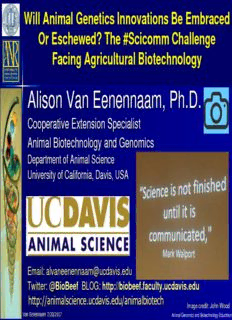
Alison Van Eenennaam, Ph.D. PDF
Preview Alison Van Eenennaam, Ph.D.
Will Animal Genetics Innovations Be Embraced Or Eschewed? The #Scicomm Challenge Facing Agricultural Biotechnology Alison Van Eenennaam, Ph.D. Cooperative Extension Specialist Animal Biotechnology and Genomics Department of Animal Science University of California, Davis, USA Email: [email protected] Twitter: @BioBeef BLOG: http://biobeef.faculty.ucdavis.edu http://animalscience.ucdavis.edu/animalbiotech Image credit: John Wood Van Eenennaam 7/20/2017 Animal Genomics and Biotechnology Education Plant and animal breeders have perhaps the most compelling sustainability story of all time Chart from Matt DiLeo/USDA https://grist.files.wordpress.com/2015/12/corn-hybrid-yields.jpeg Van Eenennaam 7/20/2017 Animal Genomics and Biotechnology Education 1944: 25.6 million animals; total annual milk production of 53.1 billion kg. 1997: 9.2 million animals; total annual milk production of 84.2 billion kg. About half of this 369% increase in production efficiency is attributable to genetic improvement enabled by AI A I VandeHaar, M.J. and St-Pierre, N. (2006). Major Advances in Nutrition: Relevance to the Sustainability of the Dairy Industry. Journal of Dairy Science89, 1280-1291. Van Eenennaam 7/20/2017 Animal Genomics and Biotechnology Education Artificial insemination was initially a controversial technology “In the initial stages of attempting to develop AI there were several obstacles. The general public was against research that had anything to do with sex. Associated with this was the fear that AI would lead to abnormalities. Finally, it was difficult to secure funds to support research because influential cattle breeders opposed AI, believing that this would destroy their bull market.” Foote, R.H. 2002. The history of artificial insemination: Selected notes and notables. J. Anim. Sci., 80 (E. Suppl.) (2002), pp. E22–E32 Van Eenennaam 7/20/2017 Animal Genomics and Biotechnology Education Capper, JL and DE Bauman, 2013. The Role of Productivity in Improving the Environmental Sustainability of Ruminant Production Systems. Annual Review of Animal Biosciences. 1 pp. 9.1–9.21 Van Eenennaam 7/20/2017 Animal Genomics and Biotechnology Education And the Irish Beef Genomics scheme get this Van Eenennaam 7/20/2017 Animal Genomics and Biotechnology Education The 8-week old body weight of broiler (meat) chickens has increased from 0.81 kg to 3.14 kg over the period 1957 to 2001, and approximately 80% of this four-fold increase has been the result of genetic selection. Havenstein, G., et al. (2003). Growth, livability, and feed conversion of 1957 versus 2001 broilers when fed representative 1957 and 2001 broiler diets. Poultry Science82, 1500-1508. Van Eenennaam 7/20/2017 Animal Genomics and Biotechnology Education What if we had not # animals killed for food 2009 genetically improved our food animals? 1.3 billion pigs 2.6 billion ducks 52 billion chickens • 59 million tons eggs • 90 million tons meat Van Eenennaam 7/20/2017 Animal Genomics and Biotechnology Education 2014 total 2014 Amount Additional production needed at needed 1950s rate Soybeans 3,927,090,000 BU 82,591,000 180,971,889 ~ 98 million Acres Acres Acres (235,562,540,000 lb) (106,849,370,802 kg) (33,423,392 ha) (73,236,725 ha) (~40 million ha) Corn 14,215,532,000 BU 83,136,000 372,134,346 ~ 289 million Acres Acres Acres (796,069,979,000 lb) (361,091,268,460 kg) (33,643,946 ha) (150,597,427 ha) (~120 million ha) Dairy cattle 206,046,000,000 lbs 9,257,166 head 38,774,181 head ~ 30 million head milk (93,460,893,469 kg) Broilers 51,373,100,000 lbs 8,544,100,000 16,679,545,455 ~ 8 billion head meat head head + an additional 81.5 billion lbs (23,302,446,000 kg) feed due to less efficient FCR Van Eenennaam 7/20/2017 Animal Genomics and Biotechnology Education Past and projected trends in consumption of meat and milk in developing and developed countries (Thornton, P.K. 2010 Livestock production: recent trends, future prospects. Philosophical Transactions of the Royal Society B: Biological Sciences 365:2853-2867). 600 Developing - meat ) Developed - meat t n 500 o Developing - milk i l l i m 400 Developed - milk ( n o i t 300 p m u s n 200 o c l a t 100 o T 0 1980 1990 2002 2015 2030 2050
Description: